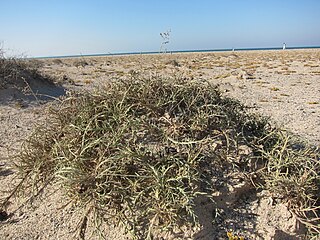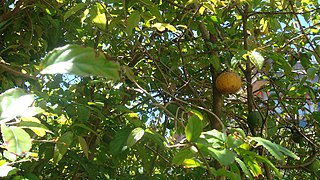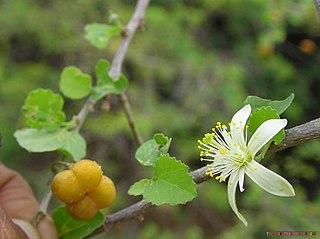
Retama is a genus of flowering bushes in the legume family, Fabaceae. It belongs to the broom tribe, Genisteae. Retama broom bushes are found natively in North Africa, the Levant and some parts of southern Europe. Retama raetam and Retama monosperma have white flowers, while Retama sphaerocarpa has yellow flowers. It remains an open question in taxonomy whether the members of the genus Retama should be incorporated into the genus Genista.

Ocimum is a genus of aromatic annual and perennial herbs and shrubs in the family Lamiaceae, native to the tropical and warm temperate regions of all 6 inhabited continents, with the greatest number of species in Africa. Its best known species are the cooking herb basil, O. basilicum, and the medicinal herb tulsi, O. tenuiflorum.

Avicennia marina, commonly known as grey mangrove or white mangrove, is a species of mangrove tree classified in the plant family Acanthaceae. As with other mangroves, it occurs in the intertidal zones of estuarine areas.

Cenchrus is a widespread genus of plants in the grass family. Its species are native to many countries in Asia, Africa, Australia, the Americas, and various oceanic islands.

Arnebia is a genus of flowering plants in the family Boraginaceae. There are about 36 species, most are located in the Mediterranean region and eastwards to the Himalayas and northern China, with one species extending into tropical Africa.

Melhania is a genus of small shrubs or herbaceous plants. Traditionally included in the family Sterculiaceae, it is included in the expanded Malvaceae in the APG and most subsequent systematics. The genus is named for Mount Melhan in Yemen.

Aerva is a genus of plants in the family Amaranthaceae. Its species are native to the palaeotropics, throughout continental Africa, Madagascar and smaller islands, through parts of the Middle East, India, and southeast Asia. Aerva javanica is an alien in northern Australia.

Panicum turgidum is an old world clumping desert bunchgrass of the genus Panicum. It is a plant of arid regions across Africa and Asia, and has been introduced to other parts of the world.

Odyssea is a genus of African and Arabian plants in the grass family.

Oncoba spinosa, the snuff-box tree, fried egg tree or fried-egg flower, is a plant species in the genus Oncoba.

Suaeda vera, also known as shrubby sea-blite, shrubby seablight or in the USA sometimes as alkali seepweed, is a species of flowering plant in the family Amaranthaceae. It is a small shrub, with very variable appearance over its wide range. It is a halophyte, and occurs in arid and semi-arid saltflats, salt marshes and similar habitats.
Caroxylon imbricatum, synonym Salsola imbricata, is a small species of shrub in the family Amaranthaceae. It grows in deserts and arid regions of north Africa, the Arabian Peninsula and southwestern Asia.
Caucanthus is a genus of flowering plants belonging to the family Malpighiaceae.
Cycniopsis is a genus of flowering plants belonging to the family Orobanchaceae.

Grewia tenax, called the phalsa cherry, white crossberry, raisin bush, gangara, gangu, or kanger, is a species of flowering plant in the family Malvaceae. It is native to Africa, from the Sahara to Tanzania and parts of southern Africa, the Arabian Peninsula, and on to the Indian Subcontinent. The ripe fruit is edible and is consumed by local peoples either fresh, dried, or powered in drinks.
Digera muricata is a species of flowering plant belonging to the family Amaranthaceae. It is the sole species in genus Digera. It is an annual native to parts of Africa and Asia, ranging from Egypt to Tanzania in eastern Africa, and to Madagascar, the Arabian Peninsula, Afghanistan, the Indian Subcontinent, Myanmar, southeastern China, Sumatra, Java, Sulawesi, and the Maluku Islands.

Droguetia is a genus of flowering plants belonging to the family Urticaceae.

Noaea is a genus of flowering plants belonging to the family Amaranthaceae. It is in the Salsoloideae subfamily.
Schouwia is a monotypic genus of flowering plants belonging to the family Brassicaceae. It only contains one known species, Schouwia purpurea(Forssk.) Schweinf.

Moltkiopsis is a monotypic genus of flowering plants belonging to the family Boraginaceae. The only species is Moltkiopsis ciliata.















